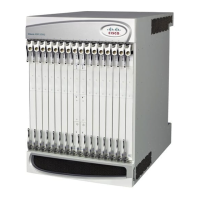Adding Static Routes to a Context
To add static routes to a context configuration, you must know the names of the interfaces that are configured
in the current context. Use the show ip interface command to list the interfaces in the current context (Exec
mode).
Information for all interfaces configured in the current context is displayed as shown in the following example.
[local]host_name# show ip interface
Intf Name: Egress 1
Description:
IP State: Up (Bound to slot/port untagged ifIndex 402718721)
IP Address: 192.168.231.5
Subnet Mask: 255.255.255.0
Bcast Address: 192.168.231.255
MTU: 1500
Resoln Type: ARP ARP timeout: 3600 secs
L3 monitor LC-port switchover: Disabled
Number of Secondary Addresses: 0
Total interface count: 1
The first line of information for each interface lists the interface name for the current context as shown in the
example output. In this example, there is one interface with the name Egress 1.
config
context context_name
ip route { ip_address [ ip_mask ] | ip_addr_mask_combo } { next-hop next_hop_address | egress_name
[ precedence precedence [ cost cost ]
Notes:
•
You can configure a maximum of 1,200 static routes per context. Save your configuration as described
in the Verifying and Saving Your Configuration chapter.
Deleting Static Routes From a Context
Use the following configuration example to remove static routes from a context's configuration:
config
context context_name
no ip route { ip_address ip_mask | ip_addr_mask_combo } next_hop_address egress_name [
precedence precedence ] [ cost cost ]
Notes
•
Save your configuration as described in the Verifying and Saving Your Configuration chapter.
OSPF Routing
This section gives an overview of Open Shortest Path First (OSPF) routing and its implementation in the
system. It also describes how to enable the base OSPF functionality and lists the commands that are available
for more complex configurations.
You must purchase and install a license key before you can use this feature. Contact your Cisco account
representative for more information on licenses.
ASR 5500 System Administration Guide, StarOS Release 21.4
274
Routing
Adding Static Routes to a Context

